| 1 |
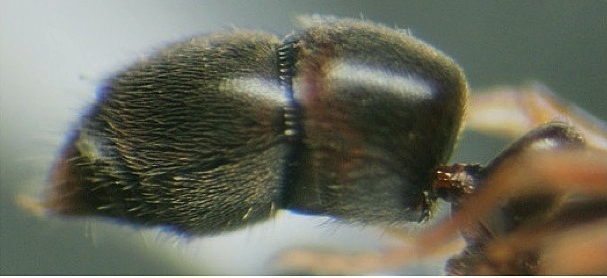 In dorsal view the base
of the cinctus of the second gastral tergite (Abd. IV) is traversed by
crowded longitudinal short cross-ribs or a continuous distinct row of
aligned coarse punctures with raised margins between them [of
restricted use as this is not visible in many specimens] In dorsal view the base
of the cinctus of the second gastral tergite (Abd. IV) is traversed by
crowded longitudinal short cross-ribs or a continuous distinct row of
aligned coarse punctures with raised margins between them [of
restricted use as this is not visible in many specimens]
|
2 |
| -- |
 In dorsal view the base of the cinctus of
the second gastral tergite (Abd. IV) is smooth and shining, not
traversed by crowded longitudinal short cross-ribs and without a
continuous row of aligned coarse punctures with raised margins between
them In dorsal view the base of the cinctus of
the second gastral tergite (Abd. IV) is smooth and shining, not
traversed by crowded longitudinal short cross-ribs and without a
continuous row of aligned coarse punctures with raised margins between
them |
44 |
| 2 |
Metanotal groove sharply
and conspicuously present in dorsal view as a depressed transverse
groove that clearly interrupts the surface |
3 |
| -- |
Metanotal groove absent or vestigial in
dorsal view; at most there may be a slight change of angle between
mesonotum and propodeum, or a superficial transverse line, or rarely
there may be the merest vestige of a shallow depression, but the
surface is not clearly interrupted by a transverse groove |
7 |
| . |
Metanotal groove sharply
and conspicuously present in dorsal view as a depressed transverse
groove that clearly interrupts the surface |
boerorum-group . |
| 3 |
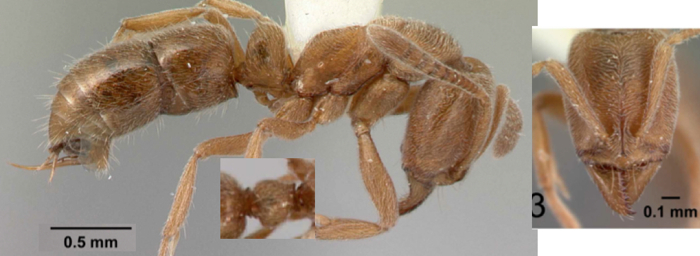 Disc of second gastral
tergite almost entirely smooth; sculpture consists only of minute
superficial punctures that are separated by very wide areas of shining,
polished cuticle. Eye variably developed, either absent or of a single
ommatidium, or a small, feature less blister. Full adult colour light
brown Disc of second gastral
tergite almost entirely smooth; sculpture consists only of minute
superficial punctures that are separated by very wide areas of shining,
polished cuticle. Eye variably developed, either absent or of a single
ommatidium, or a small, feature less blister. Full adult colour light
brown
|
Zimbabwe,
South Africa -
ignavia |
| -- |
Disc of second gastral tergite densely
punctate, reticulate-punctate, or with a microreticulate appearance,
without minute punctures separated by broad shining areas. Eye present,
small but usually conspicuous
|
4 |
| 4 |
Dorsum of first gastral
tergite (Abd. III) without conspicuous standing setae that arise along
the entire length of the sclerite when viewed in profile. Scape
relatively longer, SI 88–96 (SL/HL 0.75–0.80). Full adult colour
blackish brown to black. At least anterior portion of propodeal dorsum
finely and densely reticulate-punctate and opaque |
5 |
| -- |
Dorsum of first gastral tergite with
conspicuous standing setae that arise along the entire length of the
sclerite when viewed in profile. Scape relatively shorter, SI 77–85
(SL/HL 0.66–0.76). Full adult colour yellow to light brown. Propodeal
dorsum smooth and shining, with only very inconspicuous, scattered
minute superficial punctures |
6 |
| 5 |
 Dorsum
of propodeum
finely sculptured everywhere; the sculptured dorsum contrasts strongly
with the smooth shining declivity and the transition between the two is
sharp and abrupt. Metanotal groove in dorsal view narrow and simple,
without a defined metanotal sclerite. Punctate sculpture on pronotal
and mesonotal dorsa dense, sharply defined and obvious. Full adult
colour dark brown, blackish brown, or mostly black; sometimes with
reddish areas Dorsum
of propodeum
finely sculptured everywhere; the sculptured dorsum contrasts strongly
with the smooth shining declivity and the transition between the two is
sharp and abrupt. Metanotal groove in dorsal view narrow and simple,
without a defined metanotal sclerite. Punctate sculpture on pronotal
and mesonotal dorsa dense, sharply defined and obvious. Full adult
colour dark brown, blackish brown, or mostly black; sometimes with
reddish areas |
South
Africa - sulcatinasis |
| -- |
 Dorsum of propodeum with sculpture fading
out posteriorly so that the posterior half is almost smooth; without a
sharp and abrupt transition between sculptured dorsum and smooth
declivity. Metanotal groove in dorsal view broad, with a narrow
metanotal sclerite defined. Punctate sculpture on pronotal and
mesonotal dorsa sparse, weakly defined and superficial. "A large,
darkly coloured species". Dorsum of propodeum with sculpture fading
out posteriorly so that the posterior half is almost smooth; without a
sharp and abrupt transition between sculptured dorsum and smooth
declivity. Metanotal groove in dorsal view broad, with a narrow
metanotal sclerite defined. Punctate sculpture on pronotal and
mesonotal dorsa sparse, weakly defined and superficial. "A large,
darkly coloured species".
|
South Africa - transvaalensis |
| 6 |
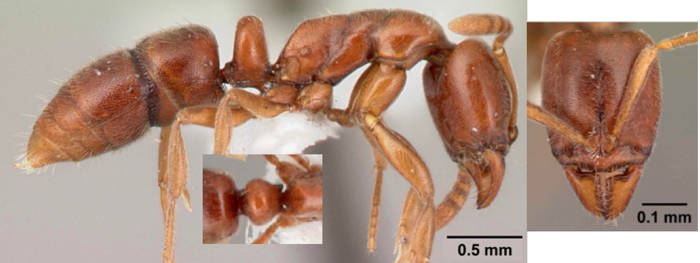 Setae
on dorsum of first
gastral tergite (Abd. III) long and fine. In full-face view the apex of
the scape, when laid straight back from its insertion, just fails to
reach or just touches the midpoint of the posterior cephalic margin.
Larger species with petiole relatively broader, HW 0.61– 0.74, PeNI
68–76, DPeI 150–180. Full adult colour yellowish brown to medium brown Setae
on dorsum of first
gastral tergite (Abd. III) long and fine. In full-face view the apex of
the scape, when laid straight back from its insertion, just fails to
reach or just touches the midpoint of the posterior cephalic margin.
Larger species with petiole relatively broader, HW 0.61– 0.74, PeNI
68–76, DPeI 150–180. Full adult colour yellowish brown to medium brown
|
South
Africa - spei |
| -- |
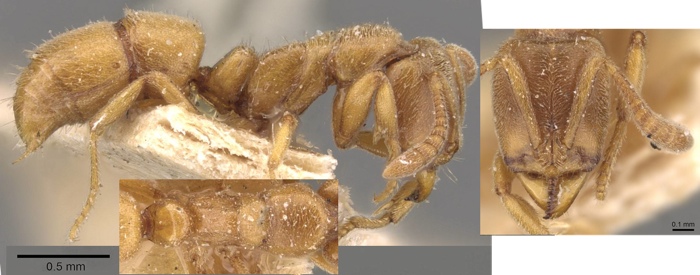 Setae on dorsum of first gastral tergite
short, stiff and stubbly. In full-face view the apex of the scape, when
laid straight back from its insertion, distinctly fails to reach the
midpoint of the posterior cephalic margin. Smaller species with petiole
relatively narrower, HW 0.56–0.60, PeNI 61–65, DPeI 140–158. Full adult
colour yellow. Setae on dorsum of first gastral tergite
short, stiff and stubbly. In full-face view the apex of the scape, when
laid straight back from its insertion, distinctly fails to reach the
midpoint of the posterior cephalic margin. Smaller species with petiole
relatively narrower, HW 0.56–0.60, PeNI 61–65, DPeI 140–158. Full adult
colour yellow.
|
South Africa - boerorum |
| . |
Metanotal groove absent or vestigial in
dorsal view |
. |
| 7 |
Base of posterior face
of petiole node with a radiating series of about 4–8 short straight
cuticular ridges that arise just above the peduncle and extend a short
distance up the posterior surface of the node [unworkable]
|
8 |
| -- |
Base of posterior face of petiole node
smooth, flat or with a transverse groove or ridge above the peduncle,
but without a radiating series of cuticular ridges that arise on the
posterior surface just above the peduncle [unworkable]
|
18 |
| 8 |
Lateroventral surfaces
of head completely covered with very coarse and distinct
reticulate-punctate to punctate-rugulose sculpture; without areas of
smooth, shining cuticle between separated discrete punctures
|
9 |
| -- |
Lateroventral surfaces of head at most
with small punctures that are separated by areas of smooth, shining
cuticle that are at least as wide as the puncture diameters; sometimes
only minute diffuse superficial punctate sculpture is present so that
the surface is mostly smooth
|
10 |
| 9 |
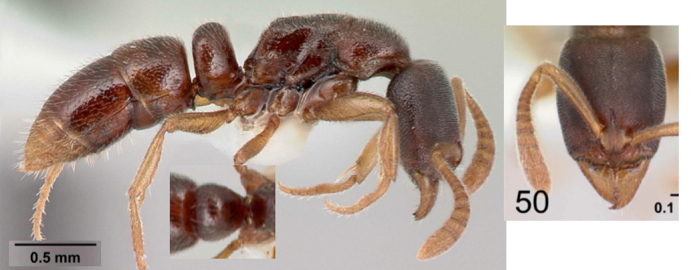 Eye absent. Smaller
species: HW 0.64–0.67, HS 0.700–0.735, SL 0.54–0.57, HFL 0.58–0.62, PeH
0.52–0.54, PeS 0.393– 0.417. Pronotal dorsum, except along the midline,
densely and coarsely reticulate-punctate, the sculpture nearly as
strong as that on the coarsely reticulate-punctate dorsum of the head Eye absent. Smaller
species: HW 0.64–0.67, HS 0.700–0.735, SL 0.54–0.57, HFL 0.58–0.62, PeH
0.52–0.54, PeS 0.393– 0.417. Pronotal dorsum, except along the midline,
densely and coarsely reticulate-punctate, the sculpture nearly as
strong as that on the coarsely reticulate-punctate dorsum of the head
|
Rwanda
- hebes |
| -- |
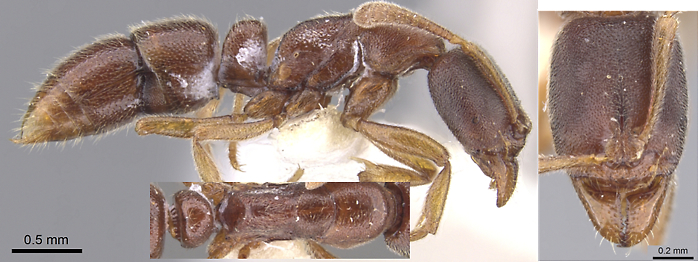 Eye present and conspicuous, of 5–6 small
ommatidia. Larger species: HW 0.72, HS 0.800, SL 0.66, HFL 0.72, PeH
0.58, PeS 0.427. Pronotal dorsum, except along the midline, sculptured
with spaced small punctures, the sculpture much more sparse and feeble
than that on the dorsum of the head. Colour not stated. Eye present and conspicuous, of 5–6 small
ommatidia. Larger species: HW 0.72, HS 0.800, SL 0.66, HFL 0.72, PeH
0.58, PeS 0.427. Pronotal dorsum, except along the midline, sculptured
with spaced small punctures, the sculpture much more sparse and feeble
than that on the dorsum of the head. Colour not stated.
|
Ethiopia - faex |
| 10 |
Row of cuticular ridges
at base of posterior face of petiole node bounded dorsally by a darkly
coloured arched transverse rim or carina; the cuticular ridges lie
within a shallow transverse groove of which the dark rim or carina is
the upper margin [unworkable]
|
11 |
| -- |
Row of cuticular ridges at base of
posterior face of petiole node not bounded dorsally by an arched
transverse dark rim or carina; the cuticular ridges not lying within a
shallow transverse groove [unworkable] |
12 |
| 11 |
 Smaller species, HL
0.55, HW 0.43, SL 0.36, HS 0.490, PeH 0.30; with petiole node
relatively narrower, PeNI 67, DPeI 157. In dorsal view maximum width of
first gastral tergite is distinctly less than width of second tergite
at its midlength. Subpetiolar process with an anteroventral angle that
is followed by a long, straight ventral surface that slopes upward
posteriorly, without an ascending angle at about the midlength of the
sternite. Full adult colour yellow Smaller species, HL
0.55, HW 0.43, SL 0.36, HS 0.490, PeH 0.30; with petiole node
relatively narrower, PeNI 67, DPeI 157. In dorsal view maximum width of
first gastral tergite is distinctly less than width of second tergite
at its midlength. Subpetiolar process with an anteroventral angle that
is followed by a long, straight ventral surface that slopes upward
posteriorly, without an ascending angle at about the midlength of the
sternite. Full adult colour yellow
|
South
Africa - traegaordhi |
| -- |
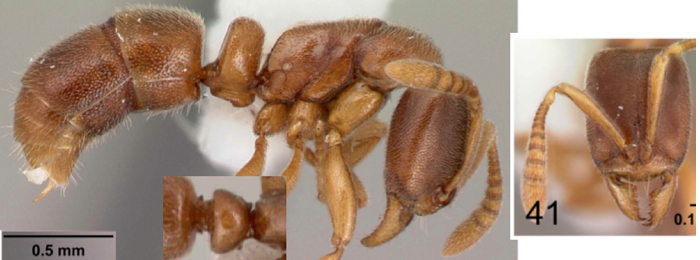 Larger species, HL 0.66–0.68, HW
0.52–0.54, SL 0.44–0.48, HS 0.590–0.610, PeH 0.40–0.43; with petiole
node relatively broader, PeNI 72–79, DPeI 168–188. In dorsal view
maximum width of first gastral tergite is subequal to or slightly
greater than width of second tergite at its midlength. Subpetiolar
process an elongate low lobe that has a short but distinct ascending
angle at about the midlength of the sternite. Full adult colour light
brown Larger species, HL 0.66–0.68, HW
0.52–0.54, SL 0.44–0.48, HS 0.590–0.610, PeH 0.40–0.43; with petiole
node relatively broader, PeNI 72–79, DPeI 168–188. In dorsal view
maximum width of first gastral tergite is subequal to or slightly
greater than width of second tergite at its midlength. Subpetiolar
process an elongate low lobe that has a short but distinct ascending
angle at about the midlength of the sternite. Full adult colour light
brown
|
Ethiopia - exigua |
| 12 |
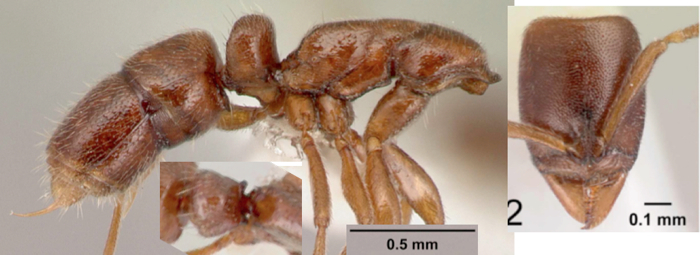 With head in full-face
view the mid-point of the anterior clypeal margin is overhung by a
small but conspicuous, acutely projecting sharp denticle that arises
from the mid-line of the clypeus just behind the margin. In profile the
denticle is seen to be the projecting sharp apex of the mid-clypeal
ridge. Colour not stated With head in full-face
view the mid-point of the anterior clypeal margin is overhung by a
small but conspicuous, acutely projecting sharp denticle that arises
from the mid-line of the clypeus just behind the margin. In profile the
denticle is seen to be the projecting sharp apex of the mid-clypeal
ridge. Colour not stated
|
Kenya -
tecta |
| -- |
With head in full-face view the mid-point
of the anterior clypeal margin blunt and rounded, without trace of a
projecting acute denticle
|
13 |
| 13 |
Petiole node in profile
relatively shorter and higher, LPeI 35–38; in dorsal view petiole node
relatively shorter and broader, DPeI179–200. Scape relatively short, SI
81–85, SL/HL 0.66–0.68
Full adult colour: cephalic dorsum black; alitrunk, petiole and gaster
dark brown [no illustration available]
|
Ethiopia
- jocosa |
| -- |
Petiole node in profile relatively longer
and lower, LPeI 43–50; in dorsal view petiole node relatively longer
and narrower, DPeI 137–170. Scape usually relatively longer, SI 82–93,
SL/HL 0.64–0.75; if SI<85 or SL/HL <0.68 then DPeI in range
140–165 |
14 |
| 14 |
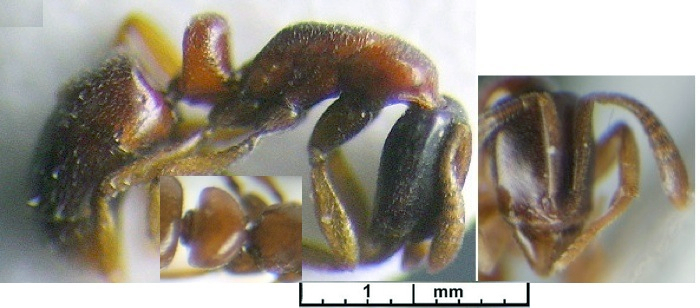 With
petiole node in
profile the anterior and posterior faces inclined and obviously
convergent dorsally. Larger species, HL 0.68–0.74, HS 0.620–0.665, SL
0.50–0.54, HFL 0.52–0.54. Colour not stated. With
petiole node in
profile the anterior and posterior faces inclined and obviously
convergent dorsally. Larger species, HL 0.68–0.74, HS 0.620–0.665, SL
0.50–0.54, HFL 0.52–0.54. Colour not stated.
|
Kenya & Tanzania -
mixta |
| -- |
With petiole node in profile the anterior
and posterior faces parallel or nearly so, at most only very slightly
convergent dorsally. Smaller species, HL 0.58–0.68, HS 0.525–0.620,
SL0.40–0.48, HFL 0.39–0.48 |
15 |
| 15 |
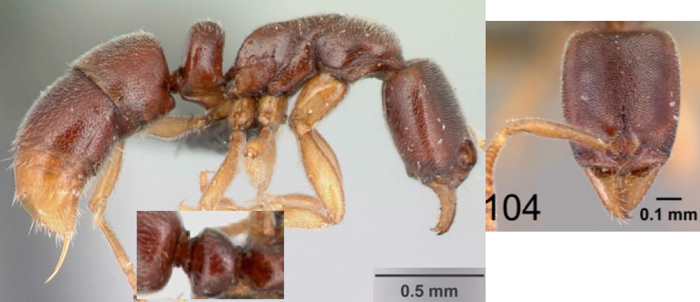 In
profile dorsum of
first gastral tergite, discounting the apical margin, densely pubescent
but without conspicuous erect hairs; at most one or two minute
standing hairs present that appear more like erect pubescence than
hairs; dorsum of second tergite the same. Petiole node relatively
broad, PeNI 76, DPeI 172. Colour brown. In
profile dorsum of
first gastral tergite, discounting the apical margin, densely pubescent
but without conspicuous erect hairs; at most one or two minute
standing hairs present that appear more like erect pubescence than
hairs; dorsum of second tergite the same. Petiole node relatively
broad, PeNI 76, DPeI 172. Colour brown.
|
Tanzania
- quaestio |
| -- |
In profile dorsa of first and second
gastral tergites, discounting the apical margins, densely pubescent and
also with numerous conspicuous short standing hairs that are usually
easily distinguished from the pubescence. Petiole node relatively
narrower, PeNI 65–74, DPeI 140–165 |
16 |
| 16 |
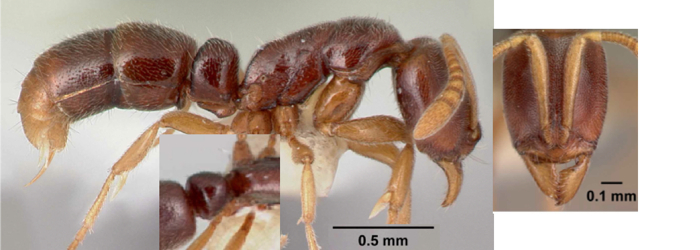 Petiole node in dorsal
view thickly D-shaped, with a strongly convex anterior margin. Petiole
larger, PeS 0.297–0.317 (PeNL 0.19–0.21, PeH 0.40–0.45, PeNW
0.28–0.30). Head larger, HS 0.585–0.620 (HL 0.63–0.68, HW 0.52–0.56).
SL/HL 0.71– 0.75. Colour not stated. Petiole node in dorsal
view thickly D-shaped, with a strongly convex anterior margin. Petiole
larger, PeS 0.297–0.317 (PeNL 0.19–0.21, PeH 0.40–0.45, PeNW
0.28–0.30). Head larger, HS 0.585–0.620 (HL 0.63–0.68, HW 0.52–0.56).
SL/HL 0.71– 0.75. Colour not stated.
|
Kenya -
surda |
| -- |
Petiole node in dorsal view not thickly
D-shaped, with a shallowly convex anterior margin. Petiole smaller, PeS
0.237–0.283 (PeNL 0.15–0.19, PeH 0.34–0.40, PeNW 0.24–0.28). Head
smaller, HS 0.525–0.580 (HL 0.58–0.64, HW 0.46–0.52). SL/HL 0.66–0.72.
|
17 |
| 17 |
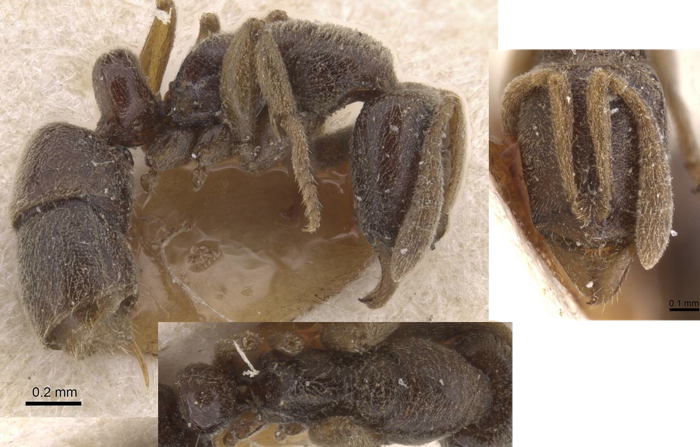 Funiculus segments 7–10
all conspicuously broader than long: the sum of the widths of funiculus
segments 7–10, divided by the sum of their lengths is1.60 or more [no
modern illustration available; too
difficult] Colour (Santschi, 1924b) quite dark brown, appendages and
apex of gaster dull yellow Funiculus segments 7–10
all conspicuously broader than long: the sum of the widths of funiculus
segments 7–10, divided by the sum of their lengths is1.60 or more [no
modern illustration available; too
difficult] Colour (Santschi, 1924b) quite dark brown, appendages and
apex of gaster dull yellow
|
Congo
Basin - ursa |
| -- |
 Funiculus
segments 7–10 gradually increase
in width apically: the sum of the widths of funiculus segments 7–10,
divided by the sum of their lengths, is 1.50 or less [too difficult],
Colour (Santschi, 1935b) clear chestnut brown, head and gaster darker Funiculus
segments 7–10 gradually increase
in width apically: the sum of the widths of funiculus segments 7–10,
divided by the sum of their lengths, is 1.50 or less [too difficult],
Colour (Santschi, 1935b) clear chestnut brown, head and gaster darker
|
Congo Basin east to
Tanzania - jeanneli |
| 17A |
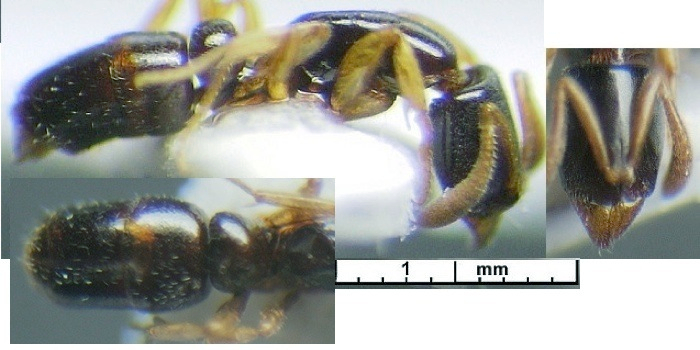 Significantly
darker and shinier Significantly
darker and shinier
Revived from B&F.
|
Congo
Basin east to
Tanzania - abyssinica |
| -- |
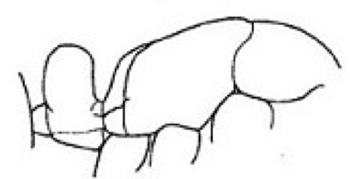 Yellow-brown, with darker head Yellow-brown, with darker head
Revived from B&F.
|
South Sudan - imatongica |
| 18 |
Either: disc of second
gastral tergite (Abd. IV) with sharply incised discrete small punctures
that are separated from each other by at least the diameter of the
punctures, the spaces between punctures glassy smooth; entire surface
without a reticulate-punctate or microreticulate appearance.
Or: in dorsal view the maximum width of the first gastral tergite (Abd.
III) is greater than the width of the second gastral tergite at its
midlength, usually obviously so; or usually both of these |
19 |
| -- |
Either: disc of second gastral tergite
(Abd. IV) appears reticulate-punctate, microreticulate or with crowded
superficial punctures whose margins are nearly confluent, so that the
surface appears disorganised; without discrete small punctures
separated by distinct smooth broad spaces.
Or: in dorsal view the maximum width of the first gastral tergite (Abd.
III) is usually less than the width of the second gastral tergite at
its midlength, at most the two are subequal; or usually both of these |
23 |
| 19 |
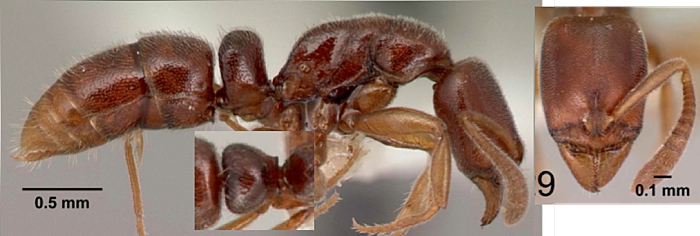 With head in full-face
view the mid-point of the anterior clypeal margin with a small, sharp
denticle; in profile this is seen as the termination of a raised, sharp
cuticular ridge on the anterior clypeal midline. Colour not stated. With head in full-face
view the mid-point of the anterior clypeal margin with a small, sharp
denticle; in profile this is seen as the termination of a raised, sharp
cuticular ridge on the anterior clypeal midline. Colour not stated.
|
Uganda,
Tanzania, Rwanda - dema |
| -- |
With head in full-face view the mid-point
of the anterior clypeal margin without a denticle
|
20 |
| 20 |
Smaller species: HL
0.53–0.64, HW 0.40–0.48, SL 0.32–0.43, HFL 0.33–0.45. With gaster in
profile the dorsum of the first tergite with abundant short, bristly
erect setae that are clearly distinguished from the underlying
pubescence |
21 |
| -- |
Larger species: HL 0.65–0.79, HW
0.50–0.60, SL 0.46–0.58, HFL 0.47–0.60. With gaster in profile the
dorsum of the first tergite without, or with only very sparse, short
setae; those that are present are scarcely distinguished from the dense
elevated pubescence |
22 |
| 21 |
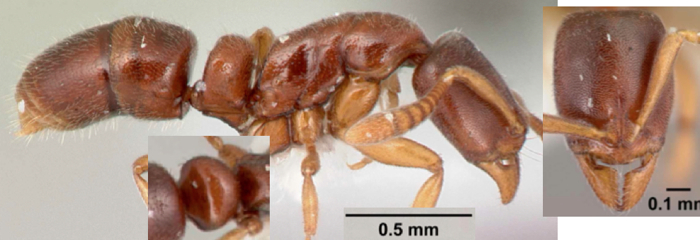 Petiole node relatively
very broad, PeNI 89–94, DPeI 170–180. Colour not stated. Petiole node relatively
very broad, PeNI 89–94, DPeI 170–180. Colour not stated.
|
Congo
Basin - molesta |
| -- |
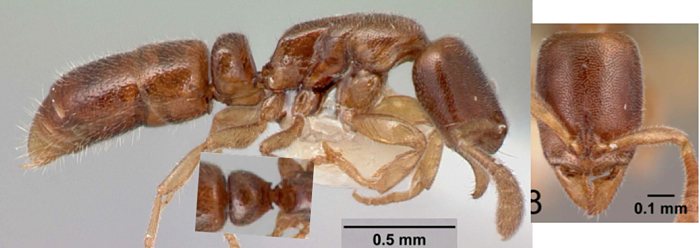 Petiole node relatively narrower, PeNI
76–82, DPeI 139–160. Colour not stated. Petiole node relatively narrower, PeNI
76–82, DPeI 139–160. Colour not stated.
|
Rwanda - venusta |
| 22 |
 Petiole node relatively
very broad, PeNI 89–94, DPeI 170–180 [may = tristis] Petiole node relatively
very broad, PeNI 89–94, DPeI 170–180 [may = tristis]
|
Congo,
Rwanda, Kenya - segnis |
| -- |
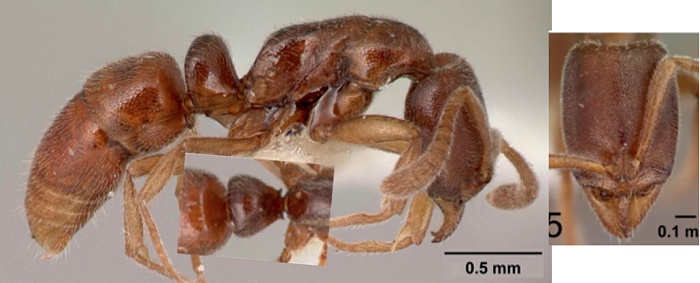 Petiole node relatively narrower, PeNI
76–82, DPeI 139–160. Colour not stated. Petiole node relatively narrower, PeNI
76–82, DPeI 139–160. Colour not stated.
|
Rwanda, Uganda - tristis |
| 23 |
 Apex of antenna very
distinctly with only 4 enlarged funicular segments that form an obvious
club. Minute species, HW 0.27– 0.35. Full adult colour yellow. Apex of antenna very
distinctly with only 4 enlarged funicular segments that form an obvious
club. Minute species, HW 0.27– 0.35. Full adult colour yellow.
|
Guinea
to Kenya - angustata |
| -- |
Apex of antenna gradually incrassate, the
incrassation involving 5–6 segments, without an obvious 4-segmented
club. Size vary from minute to moderate, HW 0.30–0.57, but usually
>0.35 |
24 |
| 24 |
Petiole node in dorsal
view narrow, relatively long in proportion to its width, as long as
broad or
only slightly broader than long; DPeI 100–120 |
25 |
| -- |
Petiole node in dorsal view shorter in
proportion to its width, usually very obviously broader than long; DPeI
125 or more, usually considerably greater |
28 |
| 25 |
Larger species, HL 0.54
or more, HW 0.40 or more, SL 0.36 or more, WL 0.70 or more, PeH 0.30 or
more; HS 0.475–0.565 and PeS 0.240–0.260. Scape relatively long, SI
90–94 and SL/HL 0.65–0.72 |
26 |
| -- |
Smaller species, HL 0.47 or less, HW 0.37
or less, SL 0.30 or less, WL 0.61 or less, PeH 0.24 or less; HS
0.350–0.420 and PeS 0.155–0.200. Scape relatively short, SI 73–85 and
SL/HL 0.57–0.66 |
27 |
| 26 |
 Width of petiole node in
dorsal view about three-quarters the width of the pronotum, PeNI 70–76;
in profile petiole relatively low in relation to its length, LPeI 67.
Smaller species, HW 0.40–0.41, SL 0.36–0.37 (SL/HL 0.65–0.69).
Anterodorsal and posterodorsal angles of petiole node in profile about
equally rounded. Full adult colour yellow Width of petiole node in
dorsal view about three-quarters the width of the pronotum, PeNI 70–76;
in profile petiole relatively low in relation to its length, LPeI 67.
Smaller species, HW 0.40–0.41, SL 0.36–0.37 (SL/HL 0.65–0.69).
Anterodorsal and posterodorsal angles of petiole node in profile about
equally rounded. Full adult colour yellow
|
Tanzania,
Zimbabwe - bulawayensis |
| -- |
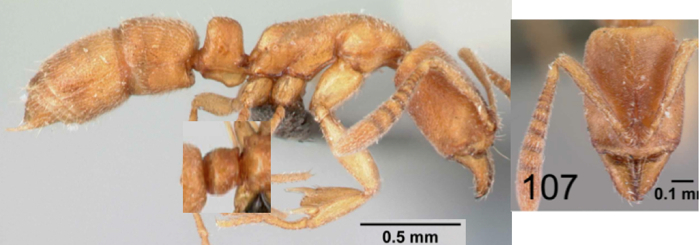 Width of petiole node in dorsal view about
half the width of the pronotum, PeNI 54; in profile petiole relatively
high in relation to its length, LPeI 58. Larger species, HW 0.49, SL
0.66 (SL/HL 0.72). Anterodorsal angle of petiole node in profile
distinctly more broadly rounded than posterodorsal angle. Full adult
colour yellow. Width of petiole node in dorsal view about
half the width of the pronotum, PeNI 54; in profile petiole relatively
high in relation to its length, LPeI 58. Larger species, HW 0.49, SL
0.66 (SL/HL 0.72). Anterodorsal angle of petiole node in profile
distinctly more broadly rounded than posterodorsal angle. Full adult
colour yellow.
|
Tanzania - regis |
| 27 |
 Petiole node broader,
PeNW 0.18–0.20, PeNI 69–77, LPeI 61–70. Scape slightly longer, SI
80–85, SL/HL 0.61–0.66. DPeI 120 is bottom of range for the species
(DPeI 120–136). Subpetiolar process absent. Full adult colour yellow. Petiole node broader,
PeNW 0.18–0.20, PeNI 69–77, LPeI 61–70. Scape slightly longer, SI
80–85, SL/HL 0.61–0.66. DPeI 120 is bottom of range for the species
(DPeI 120–136). Subpetiolar process absent. Full adult colour yellow.
Also at couplet 40
|
CAR,
Uganda - blanda |
| -- |
 Petiole node narrower, PeNW 0.14–0.16,
PeNI 61–67, LPeI 52–62. Scape slightly shorter, SI 73–81, SL/HL
0.57–0.60. DPeI 120 is top of range for the species (DPeI 108–120).
Subpetiolar process present. Full adult colour yellow. Petiole node narrower, PeNW 0.14–0.16,
PeNI 61–67, LPeI 52–62. Scape slightly shorter, SI 73–81, SL/HL
0.57–0.60. DPeI 120 is top of range for the species (DPeI 108–120).
Subpetiolar process present. Full adult colour yellow.
|
Congo, Tanzania, South
Africa - perparva |
| 28 |
Posterior face of
petiole node with a transverse groove or impression above the posterior
peduncle; the upper margin of the groove is dark, conspicuous in
posterodorsal view and located well above the peduncle (South African
species) [unworkable |
29 |
| -- |
Posterior face of petiole node without a
transverse groove or impression above the peduncle, or at most with a
weak ridge immediately adjacent to the peduncle [unworkable] |
30 |
| 29 |
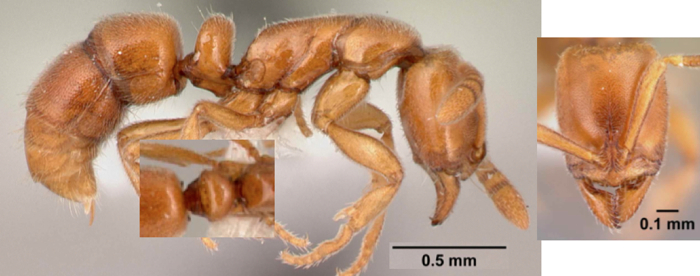 Petiole
in dorsal view
relatively broad, DPeI 160–187; in profile somewhat shorter and higher,
LPeI 41–47. Scape slightly longer, SL 0.42–0.50, SI 84–90. Dorsum of
alitrunk usually with a vestigial remnant of the metanotal groove.
Cross-ribs at base of cinctus of second gastral tergite usually long,
coarse and strongly developed [Bolton & Fisher diagnosis
questionable]. Full adult colour yellowish brown to light brown (B7F).
Santschi (1914e) had colour testaceous red, with a brown patch on the
middle of the face; mandibles, antennae, legs and gastral apex yellowish Petiole
in dorsal view
relatively broad, DPeI 160–187; in profile somewhat shorter and higher,
LPeI 41–47. Scape slightly longer, SL 0.42–0.50, SI 84–90. Dorsum of
alitrunk usually with a vestigial remnant of the metanotal groove.
Cross-ribs at base of cinctus of second gastral tergite usually long,
coarse and strongly developed [Bolton & Fisher diagnosis
questionable]. Full adult colour yellowish brown to light brown (B7F).
Santschi (1914e) had colour testaceous red, with a brown patch on the
middle of the face; mandibles, antennae, legs and gastral apex yellowish
|
South
Africa - natalensis |
| -- |
 Petiole
in dorsal view relatively narrow,
DPeI 137–150; in profile somewhat longer and lower, LPeI 47–56. Scape
slightly shorter, SL 0.38–0.42, SI 80–84. Dorsum of alitrunk usually
without trace of the metanotal groove. Cross-ribs at base of cinctus of
second gastral tergite short, delicately developed. Full adult colour
yellowish brown to light brown. Petiole
in dorsal view relatively narrow,
DPeI 137–150; in profile somewhat longer and lower, LPeI 47–56. Scape
slightly shorter, SL 0.38–0.42, SI 80–84. Dorsum of alitrunk usually
without trace of the metanotal groove. Cross-ribs at base of cinctus of
second gastral tergite short, delicately developed. Full adult colour
yellowish brown to light brown.
|
South Africa - austra |
| 30 |
 Petiole node in dorsal
view very narrow in relation to width of pronotum, PeNI 56–59. Scape
relatively long, SI 90–94. Apex of scape, when laid straight back from
its insertion, projects slightly beyond the midpoint of the posterior
margin of the head; SL/HL 0.74–0.78. Full adult colour yellow. Petiole node in dorsal
view very narrow in relation to width of pronotum, PeNI 56–59. Scape
relatively long, SI 90–94. Apex of scape, when laid straight back from
its insertion, projects slightly beyond the midpoint of the posterior
margin of the head; SL/HL 0.74–0.78. Full adult colour yellow.
|
Uganda,
Tanzania - hawkesi |
| -- |
Petiole node in dorsal view broader in
relation to width of pronotum, PeNI 63–81; if PeNI 70 or less then SI
<90. Apex of scape, when laid straight back from its insertion,
usually distinctly fails to reach the midpoint of the posterior margin
of the head, only very rarely just touches it; SL/HL0.60–0.72 |
31 |
| 31 |
Petiole in profile
relatively tall and more slender, LPeI37–44 |
32 |
| -- |
Petiole in profile relatively low and
more stout, LPeI46–70
|
35 |
| 32 |
On the second gastral
tergite (Abd. IV) the cross-ribs at the base of the cinctus very
coarse, long and stout, widely spaced and extremely conspicuous. Full
adult colour light brown to brown (as fatiga?).
[no illustration available]
|
Ethiopia
- juxta |
| -- |
On the second gastral tergite (Abd. IV)
the cross-ribs at the base of the cinctus fine and delicate, short and
slender, closely packed and often inconspicuous |
33 |
| 33 |
 Head large, HS 0.575, HW
0.51; scape longer, SL 0.44; petiole node slightly more slender, DPeI
147, PeNI 66. Full adult colour dull yellow Head large, HS 0.575, HW
0.51; scape longer, SL 0.44; petiole node slightly more slender, DPeI
147, PeNI 66. Full adult colour dull yellow
Also at couplet 36
|
Equatorial
Guinea - pulchra |
| -- |
Head smaller, HS 0.410–0.495, HW
0.36–0.44; scape shorter, SL 0.28–0.38; petiole node slightly more
broad, DPeI 155–180, PeNI 67–78 |
34 |
| 34 |
 Lateroventral surfaces
of head densely and conspicuously punctate, almost reticulate-punctate,
the punctures closely packed and sharply defined; diameters of
individual punctures generally greater than the distances between them.
Slightly larger species: HW 0.40–0.44, HS 0.455–0.495, SL 0.34–0.38,
PeH 0.33–0.38, PeS 0.227–0.260. Scape averages slightly longer, SI
84–90. Full adult colour light brown, the appendages lighter. Lateroventral surfaces
of head densely and conspicuously punctate, almost reticulate-punctate,
the punctures closely packed and sharply defined; diameters of
individual punctures generally greater than the distances between them.
Slightly larger species: HW 0.40–0.44, HS 0.455–0.495, SL 0.34–0.38,
PeH 0.33–0.38, PeS 0.227–0.260. Scape averages slightly longer, SI
84–90. Full adult colour light brown, the appendages lighter.
|
Ivory
Coast, Ghana - lassa |
| -- |
 Lateroventral surfaces of head feebly and
inconspicuously punctate, the punctures small, superficial, weakly
defined and widely separated; diameters of individual punctures less
than the distances between them. Slightly smaller species: HW 0.36–
0.40, HS 0.410–0.450, SL 0.28–0.33, PeH 0.27–0.31, PeS 0.195–0.220.
Scape averages slightly shorter, SI 78–86. Full adult colour light
brown to brown Lateroventral surfaces of head feebly and
inconspicuously punctate, the punctures small, superficial, weakly
defined and widely separated; diameters of individual punctures less
than the distances between them. Slightly smaller species: HW 0.36–
0.40, HS 0.410–0.450, SL 0.28–0.33, PeH 0.27–0.31, PeS 0.195–0.220.
Scape averages slightly shorter, SI 78–86. Full adult colour light
brown to brown |
West Africa to Tanzania -
fatiga |
| 35 |
 Clypeus in oblique
dorsolateral view without a raised median longitudinal ridge or crest.
Lateroventral surfaces of head finely but quite densely and
conspicuously punctate. Full adult colour light brown, the appendages
lighter. Clypeus in oblique
dorsolateral view without a raised median longitudinal ridge or crest.
Lateroventral surfaces of head finely but quite densely and
conspicuously punctate. Full adult colour light brown, the appendages
lighter.
|
Ivory
Coast to Gabon
- defessa |
| -- |
Clypeus in oblique dorsolateral view with
a raised median longitudinal ridge or crest. Lateroventral surfaces of
head almost entirely smooth and polished, with only a very few minute,
inconspicuous and widely separated punctulae |
36 |
| 36 |
 Head large, HS 0.575, HW
0.51. Full adult colour dull yellow Head large, HS 0.575, HW
0.51. Full adult colour dull yellow
Also at couplet 33
|
Equatorial
Guinea - pulchra |
| -- |
Head smaller,HS 0.365–0.530, HW 0.33–0.46 |
37 |
| 37 |
With petiole node in
profile either the anterior and posterior faces are vertical and
parallel, not convergent dorsally, so that length of node just above
the level of the anterior tubercle is about the same as at the points
where the anterior and posterior faces meet the dorsum; or the anterior
face is vertical and the posterior face is very slightly inclined
towards it
|
38 |
| -- |
With petiole node in profile either the
anterior and posterior faces are both inclined and converge dorsally,
so that length of node just above the level of the anterior tubercle is
distinctly greater than at the points where the anterior and posterior
faces meet the dorsum; or the posterior face is vertical and the
anterior face is inclined towards it, usually quite distinctly so
|
40 |
| 38 |
Smaller species with
petiole node narrower with respect to the pronotum; HL 0.46, SL 0.28,
WL 0.56, PeH 0.24, PeNW 0.17 (PeS 0.180); PeNI 65. Full adult colour
brown [no illustration available]
|
Uganda
- rigida |
| -- |
Larger species with petiole node broader
with respect to the pronotum; HL 0.52–0.56, SL 0.32–0.38, WL 0.67–0.70,
PeH 0.28–0.32, PeNW 0.20–0.25 (PeS 0.210–0.257); PeNI 70–78 |
39 |
| 39 |
 With petiole in profile
the posterodorsal angle distinctly rounded, not a right-angle;
posterodorsal angle more broadly rounded than the anterodorsal angle.
First gastral tegite (Abd. III) in dorsal view broader than long. Width
of first gastral tergite at posterior margin ca 1.4 × the width at the
anterior margin in dorsal view. Scape both absolutely and relatively
slightly shorter, SL 0.32–0.36, SI 82–89, SL/HL 0.62–0.65. Full adult
colour yellow to yellowish brown. With petiole in profile
the posterodorsal angle distinctly rounded, not a right-angle;
posterodorsal angle more broadly rounded than the anterodorsal angle.
First gastral tegite (Abd. III) in dorsal view broader than long. Width
of first gastral tergite at posterior margin ca 1.4 × the width at the
anterior margin in dorsal view. Scape both absolutely and relatively
slightly shorter, SL 0.32–0.36, SI 82–89, SL/HL 0.62–0.65. Full adult
colour yellow to yellowish brown.
Also at couplet 59
|
South
Africa - meridia |
| -- |
 With petiole in profile the posterodorsal
angle a right-angle or very nearly so; anterodorsal angle distinctly
more broadly rounded than the posterodorsal angle. First gastral
tergite (Abd. III) in dorsal view slightly longer than broad. Width of
first gastral tergite at posterior margin ca 1.6 × the width at the
anterior margin in dorsal view. Scape both absolutely and relatively
slightly longer, SL 0.37–0.38, SI 95, SL/HL 0.68–0.69. Full adult
colour light brownish yellow. With petiole in profile the posterodorsal
angle a right-angle or very nearly so; anterodorsal angle distinctly
more broadly rounded than the posterodorsal angle. First gastral
tergite (Abd. III) in dorsal view slightly longer than broad. Width of
first gastral tergite at posterior margin ca 1.6 × the width at the
anterior margin in dorsal view. Scape both absolutely and relatively
slightly longer, SL 0.37–0.38, SI 95, SL/HL 0.68–0.69. Full adult
colour light brownish yellow.
|
Circum-Mediterranean - abeillei |
| 40 |
 Petiole in profile
relatively lower and longer, LPeI 61–70. DPeI not greater than 136
(DPeI range 120–136). Petiole in profile without a ventral process or
at most with a minute, denticle-like projection. Full adult colour
yellow. Petiole in profile
relatively lower and longer, LPeI 61–70. DPeI not greater than 136
(DPeI range 120–136). Petiole in profile without a ventral process or
at most with a minute, denticle-like projection. Full adult colour
yellow.
Also at couplet 29
|
CAR
& Uganda
- blanda |
| -- |
Petiole in profile relatively higher and
shorter, LPeI 47–59. DPeI often greater than 136 (DPeI range 125–173).
Petiole in profile with a ventral process of some form present
|
41 |
| 41 |
 Larger species, HS
0.470–0.530. [If HS is in the range 0.470–0.480 then SI 74–80, DPeI
156–167 and PeS 0.237–0.243. Full adult colour yellow. Larger species, HS
0.470–0.530. [If HS is in the range 0.470–0.480 then SI 74–80, DPeI
156–167 and PeS 0.237–0.243. Full adult colour yellow.
|
Congo
Basin to Uganda
- camerunensis |
| -- |
Smaller species, HS 0.365–0.470. [If HS is
in the range 0.460–0.470 then SI 81–90, DPeI 125–157 and PeS
0.213–0.230.]
|
42 |
| 42 |
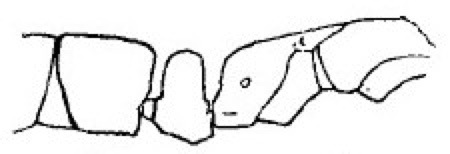 With
the following
combination of indices: LPeI 47 and DPeI 150–157 and SI 90–92. In
dorsal view the sides of the second gastral tegite (Abd. IV) are
straight and parallel; the posttergite, from the posterior margin of
the cinctus to the apex, is slightly longer than broad. Full adult
colour yellow. With
the following
combination of indices: LPeI 47 and DPeI 150–157 and SI 90–92. In
dorsal view the sides of the second gastral tegite (Abd. IV) are
straight and parallel; the posttergite, from the posterior margin of
the cinctus to the apex, is slightly longer than broad. Full adult
colour yellow. |
. |
| . |

|
Eritrea
- orba |
| -- |
With the following combination of indices:
LPeI 50–59 and DPeI 125–150 and SI 74–89. In dorsal view the sides of
the second gastral tegite (Abd. IV) are shallowly convex; the
posttergite, from the posterior margin of the cinctus to the apex, is
slightly broader than long
|
43 |
| 43 |
 With
petiole in profile
the posterodorsal angle distinctly rounded, not a right-angle;
posterodorsal angle more broadly rounded than the anterodorsal angle.
First gastral tegite (Abd. III) in dorsal view broader than long. Width
of first gastral tergite at posterior margin ca 1.4 × the width at the
anterior margin in dorsal view. Scape both absolutely and relatively
slightly shorter, SL 0.32–0.36, SI 82–89, SL/HL 0.62–0.65. Full adult
colour yellow. With
petiole in profile
the posterodorsal angle distinctly rounded, not a right-angle;
posterodorsal angle more broadly rounded than the anterodorsal angle.
First gastral tegite (Abd. III) in dorsal view broader than long. Width
of first gastral tergite at posterior margin ca 1.4 × the width at the
anterior margin in dorsal view. Scape both absolutely and relatively
slightly shorter, SL 0.32–0.36, SI 82–89, SL/HL 0.62–0.65. Full adult
colour yellow.
|
Pan-African
- coeca |
| -- |
 With petiole in profile the posterodorsal
angle a right-angle or very nearly so; anterodorsal angle distinctly
more broadly rounded than the posterodorsal angle. First gastral
tergite (Abd. III) in dorsal view slightly longer than broad. Width of
first gastral tergite at posterior margin ca 1.6 × the width at the
anterior margin in dorsal view. Scape both absolutely and relatively
slightly longer, SL 0.37–0.38, SI 95, SL/HL 0.68–0.69. Full adult
colour yellow. With petiole in profile the posterodorsal
angle a right-angle or very nearly so; anterodorsal angle distinctly
more broadly rounded than the posterodorsal angle. First gastral
tergite (Abd. III) in dorsal view slightly longer than broad. Width of
first gastral tergite at posterior margin ca 1.6 × the width at the
anterior margin in dorsal view. Scape both absolutely and relatively
slightly longer, SL 0.37–0.38, SI 95, SL/HL 0.68–0.69. Full adult
colour yellow. |
Guinea to Kenya - inaudax |
| -- |
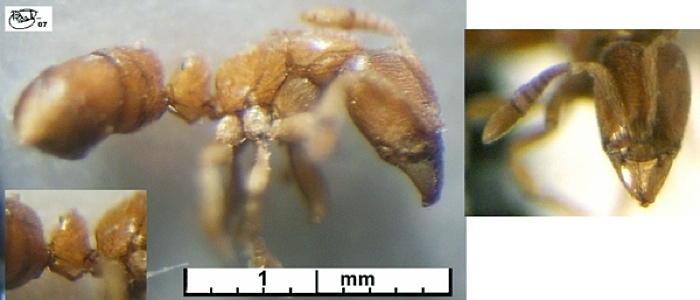 Smaller than coeca with a somewhat thicker petiole Smaller than coeca with a somewhat thicker petiole
|
Pan-African
- myrmicariae |
| . |
Cinctus of
the second gastral tergite smooth and shining |
. |
| 44 |
Metanotal groove sharply
and conspicuously present in dorsal view as a depressed transverse
groove that clearly interrupts the surface
|
45 |
| -- |
Metanotal groove absent or vestigial in
dorsal view; at most there may be a slight change of angle between
mesonotum and propodeum, or a superficial transverse line, or there may
be the merest vestige of a shallow depression, but the surface is not
clearly interrupted by a transverse groove
|
51 |
| 45 |
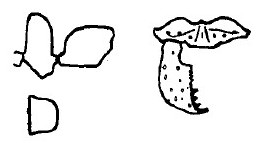 Dorsum of alitrunk
sculptured with fine transverse rugulae. Colour entirely deep yellow
(Bernard, 1952). Photographs of fragmented worker on species page. Dorsum of alitrunk
sculptured with fine transverse rugulae. Colour entirely deep yellow
(Bernard, 1952). Photographs of fragmented worker on species page.
|
Guinea
- petiolata |
| -- |
Dorsum of alitrunk usually with fine
punctate sculpture that varies in intensity and density between
species; sometimes the punctate sculpture may be almost effaced,
leaving the surface mostly smooth and shining; never with transverse
rugulae
|
46 |
| 46 |
Mesopleuron with very
fine, dense punctulate-shagreenate to minutely striolate sculpture at
least on the upper half; sculpture frequently blankets the entire
sclerite and renders it opaque; upper half of mesopleuron without
unsculptured shining areas
|
47 |
| -- |
Mesopleuron almost entirely unsculptured
and shining, at most with a few scattered small punctures on a smooth
surface; without fine dense sculpture that blankets at least the upper
half of the sclerite and renders it opaque
|
48 |
| 47 |
 Full adult colour dark
brown to almost black. Apex of scape, when laid straight back from its
insertion, touches or slightly exceeds midpoint of posterior margin of
head, SL/HL 0.72–0.78. Propodeal dorsum densely superficially
punctulate to reticulate-punctulate. Slightly larger species with
longer scape and broader petiole node, HL 0.63–0.70, HW 0.54–0.59, SL
0.47–0.54, SI 86–93, DPeI 167–188 Full adult colour dark
brown to almost black. Apex of scape, when laid straight back from its
insertion, touches or slightly exceeds midpoint of posterior margin of
head, SL/HL 0.72–0.78. Propodeal dorsum densely superficially
punctulate to reticulate-punctulate. Slightly larger species with
longer scape and broader petiole node, HL 0.63–0.70, HW 0.54–0.59, SL
0.47–0.54, SI 86–93, DPeI 167–188 |
Tramp
species & South Africa - eduardi |
| -- |
 Full adult colour dull yellow. Apex of
scape, when laid straight back from its insertion, distinctly fails to
reach midpoint of posterior margin of head, SL/HL 0.68. Propodeal
dorsum almost smooth, with scattered minute superficial punctulae.
Slightly smaller species with shorter scape and narrower petiole node,
HL 0.56, HW 0.46, SL 0.38, SI 83, DPeI 157 Full adult colour dull yellow. Apex of
scape, when laid straight back from its insertion, distinctly fails to
reach midpoint of posterior margin of head, SL/HL 0.68. Propodeal
dorsum almost smooth, with scattered minute superficial punctulae.
Slightly smaller species with shorter scape and narrower petiole node,
HL 0.56, HW 0.46, SL 0.38, SI 83, DPeI 157
|
Canary Islands
(Teneriffe) - nivariana |
| 48 |
 Petiole
node scale-like
and with a narrow dorsal surface; petiole relatively higher and
shorter, LPeI 32–39. In dorsal view node relatively thin from front to
back, DPeI 180–218. Side of alitrunk with a suture between mesonotum
and mesopleuron. In dorsal view the maximum width of the first gastral
tergite is equal to or slightly greater than the width of the second
tergite at its midlength. Scape relatively longer, SI 90–102 and SL/HL
0.74–0.83 Petiole
node scale-like
and with a narrow dorsal surface; petiole relatively higher and
shorter, LPeI 32–39. In dorsal view node relatively thin from front to
back, DPeI 180–218. Side of alitrunk with a suture between mesonotum
and mesopleuron. In dorsal view the maximum width of the first gastral
tergite is equal to or slightly greater than the width of the second
tergite at its midlength. Scape relatively longer, SI 90–102 and SL/HL
0.74–0.83
Forel described the type as reddish or red-yellow, head and antennal
club rather brownish, gaster yellow brown
Bolton & Fisher synonymies include muscicola, lamottei, mandibularis and villiersi
|
Pan-African
- dulcis |
| . |
 The workers from Congo
that I regard as lotti are very dark brown quite distinct from
the chestnut-brown dulcis
from Gabon; this is as described by Weber (1942a); synonymised with dulcis
by Bolton & Fisher (2011) The workers from Congo
that I regard as lotti are very dark brown quite distinct from
the chestnut-brown dulcis
from Gabon; this is as described by Weber (1942a); synonymised with dulcis
by Bolton & Fisher (2011)
|
Pan-African
- lotti |
| . |
 Described as yellow-gold, with yellow antenna, by
Wasmann (1918b); synonymised with dulcis
by Bolton & Fisher (2011) Described as yellow-gold, with yellow antenna, by
Wasmann (1918b); synonymised with dulcis
by Bolton & Fisher (2011) |
Pan-African
- rothkirchi |
| -- |
Petiole node not scale-like and with a
well-defined, flat to convex dorsal surface; petiole relatively lower
and longer, LPeI 43– 61. In dorsal view node relatively thick from
front to back, DPeI 120–165. Side of alitrunk without a suture between
mesonotum and mesopleuron (note: this suture present in intercastes).
In dorsal view the maximum width of the first gastral tergite is
distinctly less than the width of the second tergite at its midlength.
Scape relatively shorter, SI 75–87 and SL/HL 0.61–0.70
|
49 |
| 49 |
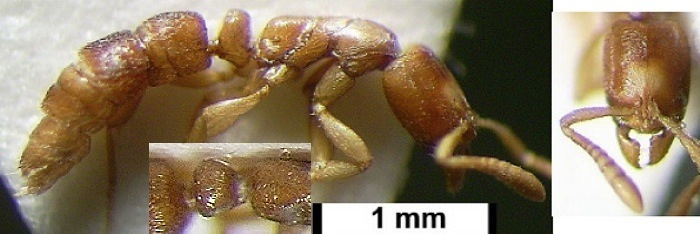 Petiole node in profile
relatively longer and lower, LPeI 55–61; in dorsal view the petiole
node relatively longer from front to back, DPeI 120–140. Colour
testaceous (Emery, 1894) Petiole node in profile
relatively longer and lower, LPeI 55–61; in dorsal view the petiole
node relatively longer from front to back, DPeI 120–140. Colour
testaceous (Emery, 1894)
|
Ethiopia,
Kenya, circum-Mediterranean
- ragusai |
| -- |
Petiole node in profile relatively shorter
and higher, LPeI 43–53; in dorsal view the petiole node relatively
shorter from front to back, DPeI 140–165 or more
|
50 |
| 50 |
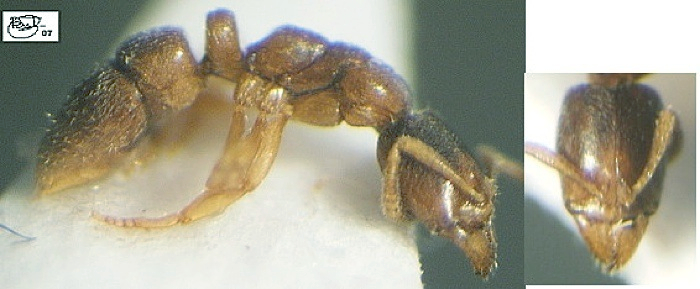 Petiole in profile with
anterior and posterior faces only weakly convergent dorsally, so that
dorsal length of node is only slightly less than length immediately
above the anterior tubercle. Dorsal midline of head with a narrow
impression that extends back from the frontal lobes and reaches beyond
the midlength of the vertex. Eye small but distinct, far forward on
side of head. Petiole in profile with
anterior and posterior faces only weakly convergent dorsally, so that
dorsal length of node is only slightly less than length immediately
above the anterior tubercle. Dorsal midline of head with a narrow
impression that extends back from the frontal lobes and reaches beyond
the midlength of the vertex. Eye small but distinct, far forward on
side of head.
Full adult colour varies from dull brownish yellow to very dark brown
or almost black. In general, workers at the bottom end of the size
range given above tend to be lighter and the colour becomes darker with
increasing size, but this is by no means an entirely consistent rule.
HL 0.56–0.72, HW 0.46–0.60, PW 33-43, CI 79–87, SI 75–84, PeNI 63–74,
LPeI 43–53, DPeI 140–165
|
Tramp
species - punctatissima |
| -- |
 Petiole
in profile with anterior and
posterior faces very strongly convergent dorsally, so that dorsal
length of node is less than half the length immediately above the
anterior tubercle. Dorsal midline of head without a narrow impression
that reaches beyond the midlength of the vertex. Eye a minute vestigial
blister, difficult to discern. Full adult colour dark brown, blackish
brown, or mostly black; sometimes with reddish areas Petiole
in profile with anterior and
posterior faces very strongly convergent dorsally, so that dorsal
length of node is less than half the length immediately above the
anterior tubercle. Dorsal midline of head without a narrow impression
that reaches beyond the midlength of the vertex. Eye a minute vestigial
blister, difficult to discern. Full adult colour dark brown, blackish
brown, or mostly black; sometimes with reddish areas
|
Guinea - sinuosa |
| 50A |
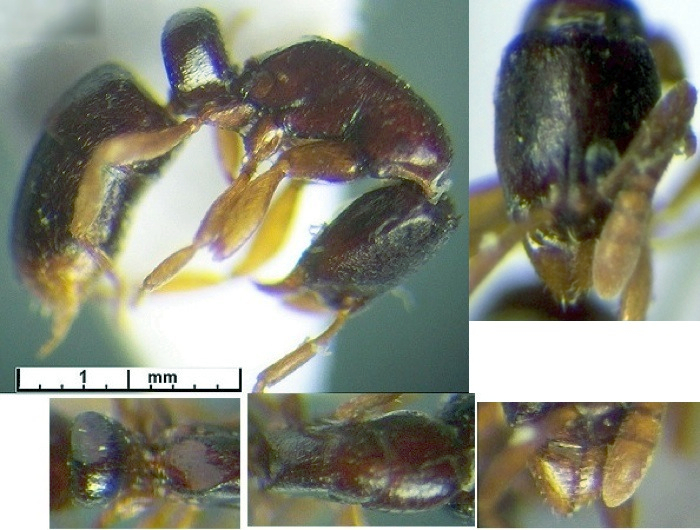 Petiole
scale a thick node, almost as wide seen from above as high, with the
anterior and posterior faces in profile completely parallel, sides also
vertircal rounding apically into a shallowly convex dorsum,
longitudinal thickness about 3/4 of transverse width; apex higher than
the level of the propodeum dorsum; propodeum declivity laterally
bordered and shallowly concave; posterior face of petiole node totally
smooth; first segment of gaster distinctly wider than second; head with
weakly convex sides and even more weakly convex occiput; clypeus with
strong median carina; without eyes; almost totally lacking in erect
hairs; head with quite coarse, dense spiculate sculpturation; rest of
body shiny brown but with faint surface roughening rather than
sculpturation, appendages contrasting orange-yellow Petiole
scale a thick node, almost as wide seen from above as high, with the
anterior and posterior faces in profile completely parallel, sides also
vertircal rounding apically into a shallowly convex dorsum,
longitudinal thickness about 3/4 of transverse width; apex higher than
the level of the propodeum dorsum; propodeum declivity laterally
bordered and shallowly concave; posterior face of petiole node totally
smooth; first segment of gaster distinctly wider than second; head with
weakly convex sides and even more weakly convex occiput; clypeus with
strong median carina; without eyes; almost totally lacking in erect
hairs; head with quite coarse, dense spiculate sculpturation; rest of
body shiny brown but with faint surface roughening rather than
sculpturation, appendages contrasting orange-yellow
HL 0.72, HW 0.60, SL 0.50, PW 0.38, WL 1.00; CI 78, SI 84, LPeI
45 PeNI 90 DPeI 188
|
South
Africa - hlavaci |
| . |
Metanotal groove absent or vestigial in
dorsal view |
. |
| 51 |
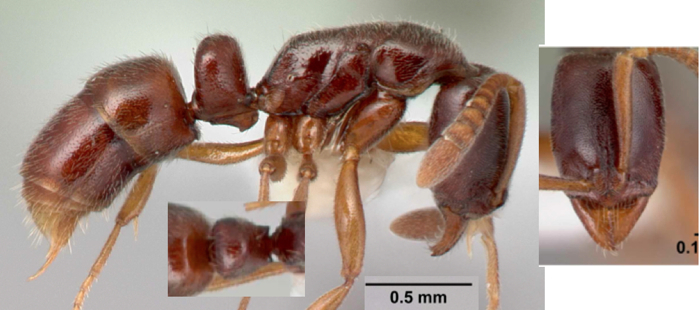 Scape relatively longer,
SI 99–108. DPeI 135–155. Apex of scape, when laid straight back in
full-face view, just touches the midpoint of the posterior margin of
the head. Colour not stated. Scape relatively longer,
SI 99–108. DPeI 135–155. Apex of scape, when laid straight back in
full-face view, just touches the midpoint of the posterior margin of
the head. Colour not stated.
|
Cameroun,
Gabon - producta |
| -- |
Scape relatively shorter, SI 78–96. If SI
in range 90–96 then either DPeI >160, or apex of scape, when laid
straight back in full-face view, fails to reach the midpoint of the
posterior margin of the head, or both of these |
52 |
| 52 |
Disc of second gastral
(Abd. IV) tergite finely, sharply punctate; the individual punctures
are sharply incised, minute and separated by wide areas of glassy
smooth cuticle; distance between punctures is distinctly greater than
puncture diameters. In dorsal view width of second gastral tergite at
its midlength is less than the maximum width of the first tergite |
53 |
| -- |
Disc of second gastral (Abd. IV) tergite
microreticulate or superficially reticulate-punctate; individual
punctures are expanded and superficial, their margins confluent and
slightly raised to give a microreticulate effect; without areas of
glassy smooth cuticle between isolated punctures. In dorsal view width
of second gastral tergite at its midlength is at least equal to, and
usually greater than, the maximum width of the first tergite
|
58 |
| 53 |
Petiole node in dorsal
view short but very broad, DPeI 182–200 (mean=190)
|
54 |
| -- |
Petiole node in dorsal view longer and
narrower, DPeI 145–180 (mean=157)
|
55 |
| 54 |
 Petiole node in profile
with anterior and posterior faces above level of anterior tubercle
parallel or very nearly so; node longer, higher and broader, PeNL
0.20–0.22, PeH 0.48–0.53, PeNW 0.38–0.41 (PeS 0.360–0.383); in dorsal
view node relatively broader with respect to pronotum, PeNI 85–95. Full
adult colour of head and alitrunk dark reddish brown Petiole node in profile
with anterior and posterior faces above level of anterior tubercle
parallel or very nearly so; node longer, higher and broader, PeNL
0.20–0.22, PeH 0.48–0.53, PeNW 0.38–0.41 (PeS 0.360–0.383); in dorsal
view node relatively broader with respect to pronotum, PeNI 85–95. Full
adult colour of head and alitrunk dark reddish brown |
Gabon,
CAR, Kenya - importuna |
| -- |
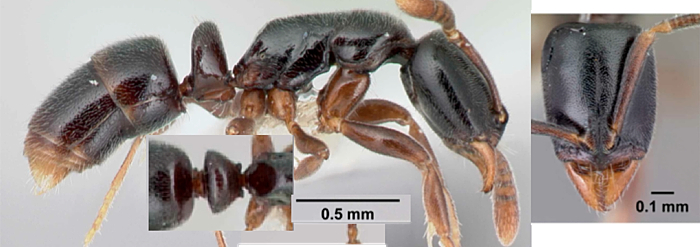 Petiole node in profile with anterior and
posterior faces above level of anterior tubercle converging dorsally;
node shorter, lower and narrower, PeNL 0.16–0.17, PeH 0.39–0.41, PeNW
0.29–0.32 (PeS 0.280–0.297); in dorsal view node relatively narrower
with respect to pronotum, PeNI 75–82. Full adult colour of head and
alitrunk blackish brown to black Petiole node in profile with anterior and
posterior faces above level of anterior tubercle converging dorsally;
node shorter, lower and narrower, PeNL 0.16–0.17, PeH 0.39–0.41, PeNW
0.29–0.32 (PeS 0.280–0.297); in dorsal view node relatively narrower
with respect to pronotum, PeNI 75–82. Full adult colour of head and
alitrunk blackish brown to black |
Tanzania - comis |
| 55 |
Larger species, HL 0.58
or more, HW 0.46 or more, SL 0.38 or more, PrW 0.35 or more, PeH 0.35
or more; HS 0.520 or more, PeS 0.280 or more
|
56 |
| -- |
Smaller species, HL 0.53 or less, HW 0.42
or less, SL 0.36 or less, PrW 0.32 or less, PeH 0.32 or less; HS 0.470
or less, PeS 0.250 or less
|
57 |
| 56 |
 With petiole in profile
the posterior face of the node vertical and straight, the anterior and
posterior faces approximately parallel; anterodorsal and posterodorsal
angles of node about equally bluntly rounded and the dorsum between
them convex. Petiole slightly higher, PeH 0.42–0.52. Generally
averaging slightly larger, HW 0.48–0.60, SL 0.44–0.55, HFL 0.46–0.58 With petiole in profile
the posterior face of the node vertical and straight, the anterior and
posterior faces approximately parallel; anterodorsal and posterodorsal
angles of node about equally bluntly rounded and the dorsum between
them convex. Petiole slightly higher, PeH 0.42–0.52. Generally
averaging slightly larger, HW 0.48–0.60, SL 0.44–0.55, HFL 0.46–0.58
Colour dull reddish-brown, head lighter and more shiny (Bernard, 1952)
|
Pan-African
- occidentalis |
| -- |
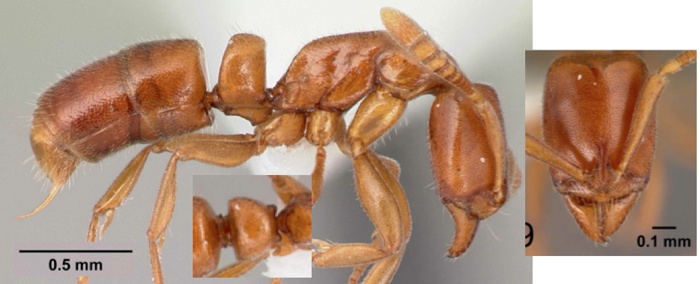 With petiole in profile the posterior face
of the node weakly convex and converging on the vertical anterior face
dorsally; anterodorsal angle of node distinctly more sharply developed
than posterodorsal angle and the dorsum between them flat. Petiole
slightly lower, PeH 0.38–0.43. Generally averaging slightly smaller, HW
0.46–0.49, SL 0.38–0.44, HFL 0.42–0.47. Colour not stated With petiole in profile the posterior face
of the node weakly convex and converging on the vertical anterior face
dorsally; anterodorsal angle of node distinctly more sharply developed
than posterodorsal angle and the dorsum between them flat. Petiole
slightly lower, PeH 0.38–0.43. Generally averaging slightly smaller, HW
0.46–0.49, SL 0.38–0.44, HFL 0.42–0.47. Colour not stated
|
Cameroun - odiosa |
| 57 |
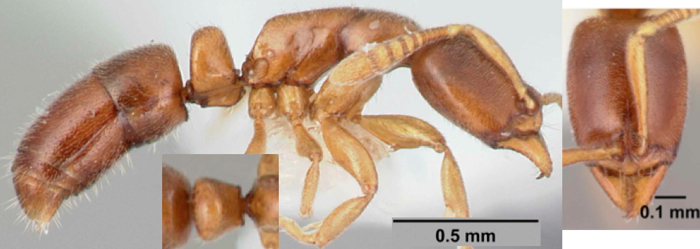 With
base of gaster in
profile the prora present, visible as a short vertical raised crest or
rim that extends from just below the helcium to the anteroventral
corner of the first gastral sternite and separating the anterior and
lateral surfaces of the sternite; prora darker in colour than the
cuticle posterior to it. Full adult colour light to medium brown With
base of gaster in
profile the prora present, visible as a short vertical raised crest or
rim that extends from just below the helcium to the anteroventral
corner of the first gastral sternite and separating the anterior and
lateral surfaces of the sternite; prora darker in colour than the
cuticle posterior to it. Full adult colour light to medium brown
|
Tanzania
- dis |
| -- |
 With base of gaster in profile the prora
absent; anterior and lateral surfaces of first gastral sternite meet in
a blunt angle but there is no raised crest or rim separating the two
surfaces. Full adult colour glossy dark brown to blackish brown. With base of gaster in profile the prora
absent; anterior and lateral surfaces of first gastral sternite meet in
a blunt angle but there is no raised crest or rim separating the two
surfaces. Full adult colour glossy dark brown to blackish brown.
|
Tanzania - aprora |
| . |
Disc of second gastral (Abd. IV)
tergite
microreticulate or superficially reticulate-punctate |
. |
| 58 |
 Petiole
node in profile
relatively short and tall, LPeI 38–47; PeH 0.32–0.39. Full adult colour
light brown, the appendages lighter. Petiole
node in profile
relatively short and tall, LPeI 38–47; PeH 0.32–0.39. Full adult colour
light brown, the appendages lighter.
|
West
Africa to CAR - lepida = lea
|
| -- |
Petiole node in profile relatively long
and low, LPeI 52–65; PeH 0.26–0.32 |
59 |
| 59 |
 With petiole in profile
the anterior
and posterior faces of the node are parallel. Petiole larger, PeNL
0.18–0.20, PeH 0.30–0.32, PeNW 0.24–0.25 (PeS 0.240–0.257). Head
relatively narrower and scape longer, CI 73–77, SI 82–86. Full adult
colour yellow to yellowish brown. With petiole in profile
the anterior
and posterior faces of the node are parallel. Petiole larger, PeNL
0.18–0.20, PeH 0.30–0.32, PeNW 0.24–0.25 (PeS 0.240–0.257). Head
relatively narrower and scape longer, CI 73–77, SI 82–86. Full adult
colour yellow to yellowish brown.
Also at couplet 39
|
South
Africa
- meridia |
| -- |
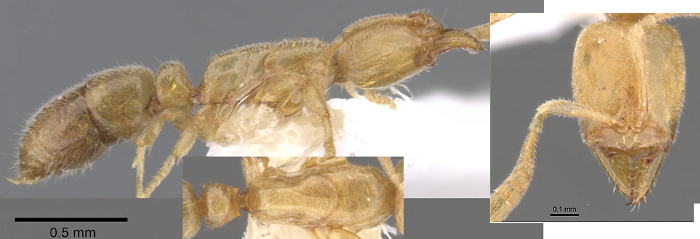 With petiole in profile the anterior and
posterior
faces of the node are inclined and converge dorsally. Petiole smaller,
PeNL 0.14–0.15, PeH 0.26–0.27, PeNW 0.20–0.21 (PeS 0.200–0.207). Head
relatively broader and scape shorter, CI 80–82, SI 78– 80. Full adult
colour yellow With petiole in profile the anterior and
posterior
faces of the node are inclined and converge dorsally. Petiole smaller,
PeNL 0.14–0.15, PeH 0.26–0.27, PeNW 0.20–0.21 (PeS 0.200–0.207). Head
relatively broader and scape shorter, CI 80–82, SI 78– 80. Full adult
colour yellow
|
Zimbabwe - obtunsa |